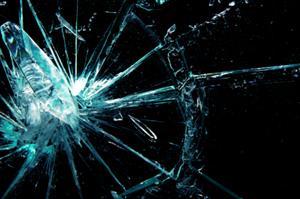| Complexity level: | 9 |
| Project cost ($): | 80 |
| Time required: | 1 day to prepare, 1 hour for the science project experiment |
| Material availability: | Easily found |
| Safety concerns: | Be extremely careful when handling sharp broken glass pieces, to prevent injuries. As the glass shatters, splinters/shards may fly in all directions. You should ensure that the experiment is conducted in a safe location, by a qualified adult, wearing protective gear/clothing. |
Hypothesis
Temperature will not have any effect on how glass shatters.
Overview
Glass
Glass is made by melting sand or silica at over 2300°C and allowing the molten liquid to cool down rapidly. The addition of other substances like sodium carbonate to the sand, helps to lower the melting temperature to about 1500°C.
Glass is a hard and solid material but it is also very brittle and fragile. It can easily break into small and sharp pieces. Glass molecules do not have a proper crystalline structure and are arranged loosely. This random structure allows visible light to pass through, making the glass transparent. However, both light and heat are able to pass through glass thereby reducing the lighting cost but increasing the cooling costs.
One of the reasons that glass breaks easily is the loose arrangement of molecules. The random arrangement of these molecules makes glass brittle and crack when stress is applied. Another reason for glass to break easily is the uneven distribution of surface temperature. Unbalanced expansion and contraction causes surface tensions and makes the glass crack.
Scientific Terms
Materials
The materials required for the science fair project experiment:
- 25 glass sheets ( 300mm x 300mm x 2.0mm thickness)
- 25 pieces of old newspaper
- 1 metal ball weighing about 250g
- 1 meter long PVC pipe, diameter should be bigger than the metal ball
- 2 bricks
- 1 freezer
- 1 hotplate
- 1 infrared thermometer
Procedure
1. For this science fair project, the independent variable is the temperature of the glass sheet - 0°C, 24°C, 50°C, 75°C and 100°C. The dependent variable is the condition of the broken glass. This is determined by observing the glass after dropping the metal ball on it. The constants (control variables) are the weight of the metal ball, height from which the metal ball is dropped and the size of the glass sheet.

2. The layout for the science fair project is prepared as shown in figure 1 above. Old newspaper is used to collect the broken glass. The 2 bricks are used to raise the glass sheet above the floor. The PVC pipe is used to guide the metal ball as it crashes onto the glass sheet.
3. The first five pieces of glass are kept in the freezer set at of 0°C. They are removed from the freezer and tested according to the test layout shown in figure 1 above. The condition of the glass after dropping the metal ball is recorded in the table given below.
4. The second five pieces of glass are tested at room temperature of 24°C. The metal ball is dropped as shown in figure 1 and your observations recorded in the table below.
5. The hot plate is used to bring the temperature of the next 5 pieces of glass to 50°C. The temperature is verified using the infrared thermometer. The metal ball is dropped as shown in figure 1 and your observations recorded in the table below.
6. Procedure 5 is repeated, this time by heating the glass plate to 75°C and 100°C. The metal ball is dropped as shown in figure 1 and your observations recorded in the table below.

Results
It was observed that the glass sheets shattered to pieces at all temperature conditions tested.
|
Glass sample |
Condition of glass sheet after dropping the metal ball (see condition below table) |
||||
|
0°C |
24°C |
50°C |
75°C |
100°C |
|
|
1 |
C |
C |
C |
C |
C |
|
2 |
C |
C |
C |
C |
C |
|
3 |
C |
C |
C |
C |
C |
|
4 |
C |
C |
C |
C |
C |
|
5 |
C |
C |
C |
C |
C |
A – glass not broken, B – glass cracked, C – glass shattered into many pieces
Conclusion
The hypothesis that temperature does not have any effect on the shattering behavior of glass is proven to be true.
Glass windows in buildings help to brighten the interior with natural lighting. Glass is a poor conductor of heat. The ultraviolet rays from the sunlight that passes through the glass will gradually increase indoor temperatures. Privacy, safety and security are also compromised due to the transparency and brittleness of the glass. Using window films can help to reflect some of this light and manage the danger caused by the shattering of the broken glass.
Also consider
This science fair project may be repeated, this time, using glass sheets of different thickness?
Modify the science project experiment, applying a different temperature at both ends of the glass and observing if it breaks.
References
Glass - http://www.lenntech.com/glass.htm
Glass - http://en.wikipedia.org/wiki/Glass
Glass facts - http://www.gpwindowfilms.com/glass-facts.html

